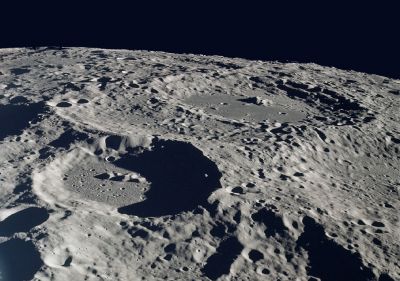Orlov
Contents
[hide]Orlov
| Lat: 25.7°S, Long: 175.0°W, Diam: 81 km, Depth: km, Rükl: (farside) |
 Apollo 17 image AS17-150-22948 (submitted by Stefan Lammel) This photo, taken from over 126-km diameter Orlov Y, shows the deeply shadowed Orlov to the lower left of center, with 125-km Leeuwenhoek near the horizon. Leeuwenhoek overlaps the similarly-sized Leeuwenhoek E (which butts up against the smaller Orlov).
Apollo 17 image AS17-150-22948 (submitted by Stefan Lammel) This photo, taken from over 126-km diameter Orlov Y, shows the deeply shadowed Orlov to the lower left of center, with 125-km Leeuwenhoek near the horizon. Leeuwenhoek overlaps the similarly-sized Leeuwenhoek E (which butts up against the smaller Orlov).
Images
LPOD Photo Gallery Lunar Orbiter Images Apollo Images
- AS17-162-24105 is one of the orbital photographs which was made with a Nikon camera (35 mm), this during the last Apollo mission in December 1972. It is centered over Orlov Y and, based on the very similar shadows, appears to be have been taken at nearly the same. It shows Orlov near the right margin, with Leeuwenhoek immediately below it (near the curved horizon), looking southwest. The large-looking crater along the top margin is an unnamed region between Orlov Y and Bok. Compare this photograph with the LAC 104 map in the Clementine Atlas. Research: Danny Caes
- Frame 57, made by ZOND 8, shows Orlov and its "row" of central peaks just "above" the grey-white rectangle near the frame's upper right corner. Research: Danny Caes
- Dept., of Lunar and Planetary Research, Moscow University, Russia.
Maps
Description
Description: Wikipedia
Additional Information
- Central peak composition: A, GNTA1, GNTA2 & AGN (Tompkins & Pieters, 1999)
Nomenclature
- This crater honors two men (twins?):
- Aleksandr Iakovlevich Orlov (1880-1954), a Soviet astronomer and geophysicist. According the IAU citation he was the founding director of the Poltava Gravimetrical Observatory, apparently a branch of the Kiev Observatory. He had a special interest in comet tails.
- Sergei Vladimirovich Orlov (1880-1958), a Soviet astronomer and (according to the IAU citation), a professor at the University of Moscow and Director of the Sternberg Institute. He also studied comets.
- This dual naming was part of the long list of farside feature names approved by the IAU in 1970 and published in Menzel, 1971.
LPOD Articles
Bibliography